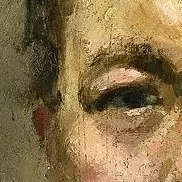Aside
For an extra boost to your enjoyment, consider listening to (Rimsky-Korsakov 2nd Symphony, Antar, movement 1: Vengeance)[https://youtu.be/Qd80g7wJWuQ?si=aZoRQ8PcU3_9OR_c]. This was the music that the artist listened to as he created the piece.
Ivan the Terrible and his son
A very sad piece indeed. Ivan the terrible’s mental illness came to a horrible climax one night when he saw his son’s pregnant wife walk by in a nightgown that exposed her under garments. Blind with rage, he struck his son in the head fataly.
The painting depicts Ivan the Terrible, stricken with grief and anguish as his son dies. The son, in tears, forgiving his father in some cosmic understanding as he lay dying.
On the surface, an example of how mental illness, left to take more and more control, can result in horrible consequences.
However, looking at the dates; the event occurred about 300 years before the painting was created. Why?
The political environment
The painting is an allegory of the assassination of Alexander II. Or rather the atrocity of the action itself and the consequences.
A group of far-left terrorists, bent on removing the autocratic tsarist government, killed A2 with a bomb in 1881; influenced by “Propaganda by the Deed,” hoping it would spark a revolution.
The painter not only witnessed the assassination, but also the hanging a few months later of the men who committed the act. He was horrified by the violence, he called them horrors of the contemporary world.
Aftermath
The act of terrorism failed and it would not be for another nearly 40 years, when things had gotten so bad and the tsars so weak that the Bolsheviks were able to succeed and establish a Soviet Republic, but only after killing basically everyone that knew how to do anything: Doctors, Lawyers, Farmers, etc. Leaving the country in tatters and the government free to be run by one person, who would go on to commit awful such atrocities that it made the whole history of the tsars look like childs play in comparison.


Perhaps an exaggeration?
Life expectancy did increase, with a few blips in the 1930’s, but this doesn’t seem particularly out of the ordinary, it also increased during the Tsarist government if you look outside of the Sino-Japanese War and WWI era. There really isn’t much consensus here, as well as a marked increase in living standards.
Other countries during that time period also had significant life expectancy increases over that period, which I think is just attributed to better infant mortality rates.
The only metric that that could be demonstrably better than than the Tsarist regime was education levels and literacy as a whole.
It was really from mid-1930’s that Soviet Russia was actually pulling away from the Tsarist regime. But who’s to tell that, had not WWI happened that gradual development would happen under the Tsar, or even the Provisional Government?
Germany had been worried about Russia’s potential since both the German Empire and the Third Reich.
Similarly, you do see a different rate of industrialisation from post-WWII China and Japan.